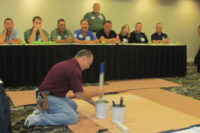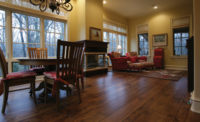
Domino, part of APC Cork’s Kids collection.
Flooring products used in healthcare and education environments pose special challenges to flooring manufacturers. The products used in these settings need to be able to withstand heavy traffic, offer great indoor air quality, keep bacteria from spreading, and provide a positive environment for healing and/or learning.
A wide range of products can be used, including cork, rubber and resilient flooring, linoleum, terrazzo tile, ceramic tile, and carpet. The bottom line is that the products have to perform, be safe, and be easy to maintain for the many years the flooring is put to use.

Roppe Fiesta rubber tile and stair treads in Avahar, with Blue accent tiles, installed at the Summerlin Library in Las Vegas.
According to Edward “Chip” Braulick, CBC Flooring’s sr. marketing manager, performance is especially important in healthcare. “In healthcare of course there is no downtime, unlike education where you have the schools out of session. Rolling loads, and heavy furniture such as beds being moved, can be as challenging on the flooring as any environment.”
Easier maintenance is achieved by factory and on-site applied finishes, he added. “Low maintenance options are almost a requirement now in many specifications.”
Michael Blasek, Altro’s national sales manager, noted that creating floors that are stain-resistant is essential for installations that will go into operating rooms. “The ORs are the profit centers of these institutions and frequent renovations hurt the bottom line. If antiseptics are staining the floors shortly after renovations, administrators become incensed since they know the opportunity to retrofit may not be for years down the road.”
Safety is extremely important in these environments, Blasek said. “Slip-resistant flooring not only reduces the facility’s liability, but can lower insurance premiums.”
Making products with great indoor air quality benefits is also important, noted R. Lanny Trottman, president of Global Market Partners Inc., which makes the Qu-Cork brand of cork flooring. “In hospitals especially, you have to make sure the products you use comply with very strict indoor air standards,” he said.

Linotesta resilient flooring from CBC Flooring, shown here in a hospital environment.
Natural flooring materials such as cork are great for schools and medical facilities, said Sheila Furtney, WE Cork’s technical advisor. Cork contains a naturally occurring substance called suberin, which repels insects, mites and mold. “This makes cork a great product for people with allergies, as it is naturally hypoallergenic.” Cork flooring is also anti-static and comfortable during long periods of standing, she added.
Melissa Quick, Flexco’s marketing coordinator said sound reduction is important in both schools and hospitals. “The noise factor in both types of facilities is always a huge issue,” she said. “And in hospitals, people are healing and don’t need to be bothered by lots of noise.”
Toby Steinbeck, operations manager for terrazzo tile maker Nurazzo, noted that offering a product with great sustainability is critical. Facility managers and commercial specifiers are not only looking for environmental sustainability, which is a requirement of all commercial projects, but product durability, he said.

Johnsonite’s Harmonium xf linoleum.
Mark Brunelle, USFContract’s national sales manager, agreed. “If a product offers a healthier solution and is beneficial to the environment while upholding the durability, performance and maintenance, it certainly makes good business sense in the long run for these institutions.”
Cindy Mansfield, Johnsonite’s marketing communications manager, also sees sustainability as vitally important in both hospitals and schools. “Our Eco-Naturals rubber flooring contains walnut shell dust and cork,” she explained. “The cork and walnut shell dust each qualify as a rapidly renewable resource and a pre-consumer waste stream material. … And our linoleum product has become a popular choice because of the rapidly renewable aspect.”
Sean Cilona, Florida Tile’s director of marketing, said technology is allowing manufacturers to increase the antimicrobial protection in ceramic products. “The trend to air quality is addressed by both limiting the VOCs through products like tile and stone, as well as new technology that uses the surface of the tile to actually filter contaminants from the air,” he said.
Design Trends
CBC Flooring’s Braulick sees healthcare flooring transitioning away from institutional looks to spa-like colors and textures. “Women’s centers use more neutral, warm tones while the pediatric areas are going to be more colorful, cheerful places.” He also sees a greater focus on color in education settings to “create character and a positive environment for children.”
USFContract’s Brunelle echoed those sentiments. “Most definitely, over the last few years the institutional look of light, non-descript products are being replaced with warmer and subtler aesthetics.”
Johnsonite’s Mansfield said healthcare designers are starting to look to nature for inspiration. “Designers for healthcare applications are trying to incorporate more naturals into the designs in subtle ways.” She added that resilient wood looks are popular, and the number of colors offered in vinyl sheet flooring has expanded.

Flexco’s Evolving Styles rubber sheet flooring in the Creative Elements color palette.
Dee Dee Brickner, Roppe’s marketing coordinator, said the color palette is largely determined by the environment its used in. “Healthcare typically prefers sheet or seamless in sterile areas, but both healthcare and educational environments are starting to see some custom designs which add interest in their large, open hallways and large gathering places.” She added that using multiple product profiles and colorways can also help hide dirt and debris.
Design flexibility is important in both healthcare and education environments, Nurazzo’s Steinbeck noted. For his company’s terrazzo tile, 90 percent of the orders are for custom jobs. “They can take the stone chip that goes into it and pick the background color. The biggest thing is we let them design their own tile.”
Flexco’s Quick is also seeing more interest in a wider array of design options. “Healthcare and education have seen a pickup in waterjet cut work, and with rubber sheet it allows for a long linear design down hallways without lots of seams.”
-
Carpet fits healthcare, education segments
Editor’s Note: NFTspoke with Werner Braun, president of the Carpet and Rug Institute, about using carpet in healthcare and education settings.
“Carpets and rugs provide numerous benefits in both sectors. Anyone who stands for prolonged periods on smooth floors can appreciate the cushioning effect carpet provides,” said Werner Braun, adding that carpet also helps reduce noise, which is ideal for both education and healthcare environments.
Braun said two of the biggest misconceptions about carpet are that it doesn’t help air quality and is hard to maintain. “The intrinsic nature of carpet allows it to hold and trap settled materials such as dust particles and other allergens. However, the industry has long considered this to be a good thing,” Braun explained. “If it is in the carpet, it’s certainly not being inhaled where it can aggravate allergies and asthma.”
He also said carpet is easy to clean. “With CRI’s Seal of Approval testing program, it’s also easier to find the right carpet cleaning products that not only work, but won’t damage the fiber or color.”
Additionally, Braun noted that the national carpet sustainable assessment standard (NSF-140) allows hospitals and education facilities to specify sustainable carpets and rugs. CRI has also developed a Texture Appearance Retention Ratings system, which allows specifiers to see what rated carpet works best for different settings.






